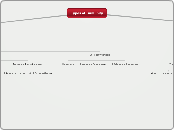por Porscha Buck 12 anos atrás
2279
Innate and Adaptive Immunity

por Porscha Buck 12 anos atrás
2279

Mais informações
Originates also in the bone marrow
Stays in the bone marrow to mature
Develop memory cells that can be used in future infections
Make antibodies against antigens, thereby performing as an Antigen-Presenting Cell (APCs)
Memory B
Plasma B
Originates in the bone marrow
In order to develop into mature T-Cells the immature must travel to the thymus
Maintains immunological tolerance - not attacking self cells
Activate cytotoxic T cells and macrophages
Destroy virally infected cells through CD8 and MHC-I
Assist other white blood cells in immunological maturation (i.e. B cells into plasma and memory B cells)
Regulatory
Memory T
Cytotoxic T
Helper T
circulates through the body when there is an infection
Take on a more active role in defeating pathogens
Complement
Antibody Independent
Alternative Pathway
Pathogen surfaces
C3 B D
Lectin Pathway
Mannose-binding lactin binds to the mannose on pathogen surfaces
MBL, MASP-1, MASP-2 C4 C2
C3 Convertase
Terminal complement components C5b C6 C7 C8 C9
MAC, lysis of certain pathogens and cells
C3b
Binds to complement receptors on phagocytes
Opsonization of pathogens and removal of immune complexes
C1q binds to the Fc region of antibody
C3a, C5a
Peptide mediators of inflammation, phagocyte recruitment
Antibody Dependent
Classical Pathway
Activated by the presence of antibodies or by the recognition of microbial surfaces by C1
An-Abo Complexes on pathogen surfaces
C1q, C1r, C1s C4 C2
Inflammation
Heat
Swelling
Redness
Pain
will circulate throughout the body constantly
Be part of the 1st and 2nd lines of defense against pathogens that can invade the human body
WBC
Dendritic Cells
Granulocytes
Mast Cells
-phils
Natural Killer Cells
Monocytes
Antimicrobials/Enzymes
Lysozymes
Defensins
Histatin
Mucous
Skin